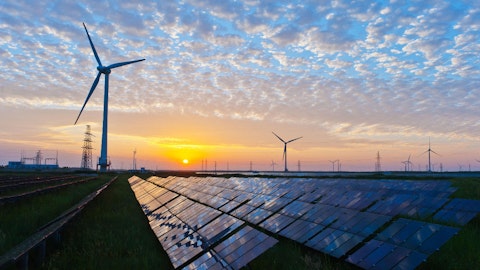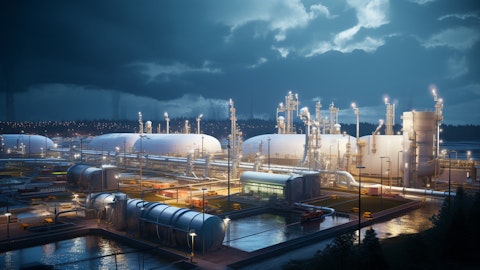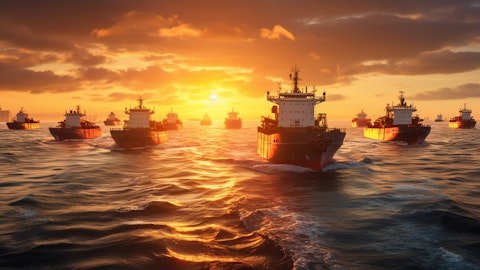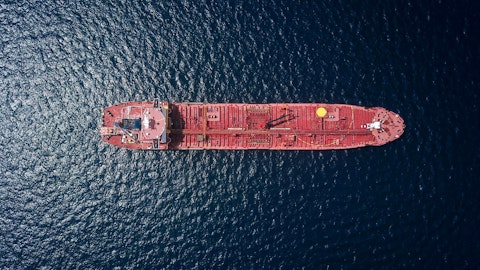Scorpio Tankers Inc. (NYSE:STNG) Q4 2023 Earnings Call Transcript February 14, 2024
Scorpio Tankers Inc. beats earnings expectations. Reported EPS is $2.75, expectations were $2.63. Scorpio Tankers Inc. isn’t one of the 30 most popular stocks among hedge funds at the end of the third quarter (see the details here).
Operator: Hello and welcome to today’s Scorpio Tankers Inc., Fourth Quarter 2023 Conference Call. I would now like to turn the call over to James Doyle, Head of Corporate Development and IR. Please go ahead, sir.
James Doyle: Thank you for joining us today. Welcome to the Scorpio Tankers, fourth quarter 2023 earnings conference call. On the call with me today are, Emanuele Lauro, Chief Executive Officer; Robert Bugbee, President; Cameron Mackey, Chief Operating Officer; and Chris Avella, Chief Financial Officer. Earlier today, we issued our fourth quarter earnings press release which is available on our website scorpiotankers.com. The information discussed on this call is based on information as of today, February 14, 2024 and may contain forward-looking statements that involve risk and uncertainty. Actual results may differ materially from those set forth in such statements. For a discussion of these risks and uncertainties, you should review the forward-looking statement disclosure in the earnings press release as well as Scorpio Tankers’ SEC filings which are available at scorpiotankers.com and sec.gov.
Call participants are advised that the audio of this conference call is being broadcasted live on the internet and is also being recorded for playback purposes. An archive of the webcast will be made available on the Investor Relations page of our website for approximately 14 days. We will be giving a short presentation today. The presentation is available at scorpiotankers.com on the Investor Relations page under Reports and Presentation. These slides will also be available on the webcast. After the presentation, we will go to Q&A. For those asking questions, please limit the number of questions to two. If you have an additional question, please rejoin the queue. Now, I’d like to introduce our Chief Executive Officer, Emanuele Lauro.
Emanuele Lauro: Thank you, James, and thank you, everybody, for joining us today. We appreciate your time. We’re pleased to report another quarter and another year of strong financial results. In the fourth quarter of 2023, the company generated $237 million in adjusted EBITDA and more than $142 million in adjusted net income. From the full year 2023, the company generated $959 million in adjusted EBITDA and more than 570 million in adjusted net income. The fundamentals which have created a strong rate environment over the last two years remain intact. Those still are increasing global demand for refined products, a dislocated refining capacity and a constrained maritime supply curve. In addition to this, we’ve seen low water levels in the Panama Canal, attacks in the Red Sea and sanctions on Russia, which had led to the rerouting of vessels.
This has made the fleet more inefficient and further tightened supply against a strong demand curve. The cash flow from the elevated rate environments are significant. They have also been transformative for our company. The balance sheets and the quality of Scorpio Tankers as an investment has become stronger and continues to improve. Deleveraging has been and remains our primary focus. Over the last few years, the company has reduced lease financing by almost $2 billion and our total debt by 1.6 billion. In the first quarter of 2024, we will repay 316 million in debt. And today our net debt stands at just a shade below $1.1 billion and we feel very well positioned at these levels. Over the last few years, we have returned $732 million to shareholders.
This has been returned through share repurchases and dividends, which includes 548 million or roughly $10 per share in 2023 alone. Today, we have announced another increase in our quarterly dividend which is now $0.40 per share. This is our fourth increase since 2022. Looking forward, we expect low global inventories robust demand and limited street growth to support the strong product tanker fundamentals which we’ve experienced in the last few years. I would just like to thank you for your continued support. And I would like to now turn the call to James for a brief presentation. Thank you. James, please.
James Doyle: Thank you, Emanuele. Slide 7, please. For the last two years, increasing demand, low inventories, refining capacity changes and limited fleet growth as led to a robust rate environment. In the fourth quarter discontinued. Our LR2 rates improved to the end of December as Middle East refining runs increased after an early maintenance season, moving from $36,000 up to $50,000 per day before any disruptions in the Red Sea. MR rates were lifted by the strength in the U.S. golf market, which offset slightly lower rates in Europe and Asia. Today, Asia and Europe are lifting rates for MRs as peak refinery maintenance in the U.S. starts to wind down this month. With low global inventories, Middle East maintenance behind us and the U.S. working through peak maintenance now, the outlook for product tankers remains very constructive.
As Emmanual mentioned, disruptions have led to new trade flows and rerouting of vessels, which is further tightened supply. However, this would not be possible without strong headline demand for refined products. Slide 8, please. Global demand for refined products has been extremely strong and we expect this to continue. Only 24 refined product demand on average is expected to surpass 2023 by 1.4 million barrels per day and will be driven by increases in jet, fuel, naphtha, diesel and gasoline. As global demand has increased, so have seaborne exports, January refined product exports average 20.6 million barrels per day, which is 1.3 million barrels per day higher than January 2019 levels. Given low global inventories, increased consumption will continue to be met through higher imports.
And not only of imports increase but barrels are traveling longer distances. Slide 9, please. While demand is above pre-COVID levels, refining capacity is more dislocated. One of the biggest challenges has been diesel; Europe, Latin America and Africa all have a diesel deficit of 1 million barrels per day. Capacity closures in Europe, North America and certain parts of Asia have been offset by increases in export-oriented capacity in the Middle East and India. Opening of new export-oriented refineries and closing of older less efficient refineries has led to an increase in seaborne exports in ton miles. We have seen this in Australia, where imports have increased already above the last production after closing 2 large refineries in 2020. Last week, it was announced that 150,000 barrels per day refinery in Scotland is expected to close and will be converted into a fuel oil terminal.
Excluding the impact of Russian exports in ton miles; ton mile demand has increased over 7% compared to 2019 levels. In other words, the structural changes in refining capacity have and continued to reshape flows in increased ton mile. As ton miles demand increases, vessel capacity has reduced and supply tightened. Slide 10, please. Disruptions have exacerbated the strong supply and demand fundamentals in our market. First 485 product tankers have carried Russian refined product, many of which are older vessels that will have a difficult time returning to the premium trades given their age and trading history. This has and will continue to benefit the supply of vessels servicing on sanction trades. Second, lower water levels in the Gatun lake which feeds the Panama Canal has led to a reduction in the number of ships allowed to transit the canal from 36 to 24 per day.

In the fourth quarter, this resulted in a reduction of 200,000 barrels a day of refined product moving through the Panama Canal and needing to travel longer distance. Third, the attacks in the Red Sea have reduced volumes going through the Suez Canal. Slide 11, please. Before the attacks on commercial vessels in the Red Sea, 2 million to 3 million barrels of refined products were transiting the Suez Canal each day, roughly 10% to 15% of the global seaborne product tanker trade. And this was about 1 million barrels a day higher than prior years because of the increase in distillate coming from the Middle East to supply Europe given sanctions on Russia. Many vessels are going around the Cape of Good Hope today, with canal volume dropping to around 200,000 barrels per day for the first week of February.
Depending on the route, this can increase the voyage length by 30% to 70%. The rerouting of vessels has made the fleet more inefficient tightening supply and leading to higher rates. Slide 12, please. New order book is 12% of the current fleet. New orders have started to slow given expensive new building prices, long lead times for delivery, and uncertainty about propulsion systems to satisfy future environmental regulation. In addition, the majority of the order book is LR2 vessels and 52% of the LR2 fleet trading and clean products today, the effective order book for vessels trading in clean is going to be less than the current 12%. Also, the fleet is aging. The average age of the product tanker fleet today is 13 years with 9% of the fleet 20 years and older.
Starting this year, 8 million deadweight tons of product tankers will turn 20 years old each year, the equivalent of 160 MRs per year. By 2026, 21% of the fleet will be 20 years and older. Slide 13, please. This year’s fleet growth is expected to be the lowest fleet growth since 2000 and less than 1%. Seaborne exports and ton-mile demand are expected to increase 2.8% and 7.3%, respectively, vastly outpacing supply. Using minimal scrapping assumptions relative to the age of the fleet, on average, the fleet will grow around 3% in 2025 and 2026 and close to 0 in 2027. In addition, one- and three-year time charter rates remain at high levels evidence that our customers’ outlook is one of increasing export and ton miles against the constrained supply curve.
The confluence of factors in today’s market are constructive individually, low inventories, increasing demand, exports and ton miles structural dislocation in the refinery system, rerouting of global product flows, limited fleet growth, upcoming environmental regulations, collectively there and precedented. With that, I would like to turn it over to Chris to go through the financial slides.
Chris Avella: Thank you, James, and good morning, good afternoon, everyone. Slide 15, please. As we have highlighted, cash flows from a strong rate environment have been significant and transformative for the company. Over the last 2 years, product tanker rates have been resilient. 2023 was a reflection of a strong market that found equilibrium after the events of 2022. As the chart in the upper left illustrates the fourth quarter of 2023 was marked by a normalized seasonal uptick in demand heading into the winter months. The impact of the recent events in the Red Sea will largely be seen in our first quarter results. Over the last 2 years, we have generated over $2 billion in EBITDA and reduced our gross outstanding debt by $1.6 billion.
In addition to that, since the fourth quarter of 2022, we have increased our quarterly dividend by 300%, and during 2023 alone, we have returned $548 million or approximately $10 per share to shareholders in the form of dividends and share repurchases. Slide 16, please. As we have stated in the past, deleveraging remains our primary focus, and we have made meaningful progress in this respect. As the chart on the left illustrates our gross outstanding debt at December 31, 2021, stood at $3.2 billion. As of today, this balance is $1.5 billion. The chart on the right shows the same progression, but more importantly, highlights the shift in the mix and composition of our debt, transitioning away from expensive lease financing into more traditional bank financing with lower costs and greater flexibility.
Looking back, $1.7 billion of our outstanding debt at December 31, 2022, consisted of lease financing obligations bearing margins of over 350 basis points on average. Today, our lease financing obligations stand at just $294 million, and we have committed to repurchasing 12 more leased vessels between now and the end of the second quarter. Once complete, these repurchases will bring our obligations under lease financing arrangements down to approximately $80 million. We have refinanced a considerable portion of our lease obligations into more traditional and lower-cost secured bank debt, which carries margins of less than 200 basis points on average. We also want to highlight that the terms and conditions of this newer debt provide the company with greater flexibility, including the ability to repay these loans at any time and $500 million of revolving credit of which $288 million is available today.
In sum, we have not only reduced our leverage, but we’ve also simplified our balance sheet through more traditional forms of financing at lower cost and more flexible terms. Slide 17, please. Looking ahead, we still have more work to do as we have committed to repurchasing $209 million of lease obligations between now and the end of the second quarter. This comes on the heels of $497.1 million in unscheduled debt and lease repayments in the fourth quarter of 2023, and $171.1 million of unscheduled debt and lease repayments thus far in the first quarter of 2024. Over the same period, we drew $423.6 million from our $1 billion credit facility and $50.2 million from our $94 million credit facility, each carrying margins below 200 basis points.
On a pro forma basis, after considering our committed lease repurchases, our gross and net debt stand at $1.3 billion and $1.1 billion, respectively. Moreover, with no new buildings on order and the expiration of options to purchase and install scrubbers on 11 of our vessels, we have manageable CapEx requirements. Slide 18, please. The company has significant operating leverage. Our first quarter of 2024 coverage across the fleet, including time charters is averaging close to $39,000 per day. At $30,000 per day, the company can generate over $750 million in free cash flow per year and that $40,000 per day, almost $1.2 billion. Additionally, our cash breakeven rate has declined, and we continue to seek ways to reduce it in a balanced and prudent manner.
And with that, I’d like to turn the call over to Q&A.
See also Top 15 Electric Bike Brands According to Reddit and 30 Highest-Grossing Media Franchises of All Time.
Q&A Session
Follow Scorpio Tankers Inc (NYSE:STNG)
Follow Scorpio Tankers Inc (NYSE:STNG)
Operator: Thank you. [Operator Instructions] Our first question comes from Jon Chappell with Evercore.
Jon Chappell: I don’t know who wants to take this one, kind of open it to the group. But clearly, as Chris just laid out, the targets on net debt are going to be achieved at some point in the early part of this year, if not at the end of the first quarter. There’s a lot more uncertainty in the world right now, obviously. So there’s been some turbocharge in rates, that’s helped you kind of accelerate the debt repayment, but I think, a lot of uncertainty on how the world plays out from here. So versus where we were 3, 6 months ago and you talked about target net debt levels and maybe shift in capital allocation, how do you see attaining those targets earlier versus maybe continuing to deleverage further just given a lot of the volatility in the markets today?
Robert Bugbee: Jon, Robert. I think that’s a great question. It’s a question that we’re obviously asking ourselves. I think that in a fortunate position with management of shareholders and that right now, this market is providing extraordinary returns. And so the one thing we know is the cash is coming in and our balance sheet is improving. We have really no idea as to whether or not this will continue, and will the Red Sea will continue to be effectively closed and helping extraordinary earnings. And so I think that we haven’t reached our target yet. We don’t intend to comment on what we would do with regard to capital return when reaching the target. We’re happy to say that we’re not looking to do new buildings and I think that it is a difficult situation to make a lot of decisions in the market environment that you have right now.
But at the same time, we’re confident, as James has pointed out, in the long-term fundamentals. So the way I’d answer it at the moment is the basic operational position of the company at the moment is that, however, unrealistic that might be, we are running the company as if the Red Sea were to open tomorrow. And on that basis, we still think that the market will be very strong. It will take a time to wind down from where we are to, let’s say, put the shipping routes together. And we’re happy to share with everybody what we would call our base case of what we would think open days would be for the rest of the quarter. And so we were internally on our base case under that assumption, working assumption I’ve given you is we would expect product MRs to be around $35,000 a day for the unfixed days and a lot to is around $60,000 for the 6 days.
So that’s healthy. So I think the best thing to say is, yes, we are moving very fast towards a deleveraged state where the company can then have a lot of choices, but we’re certainly not distracting ourselves right now on thinking what the best choices would be at that time. Whatever you do and we just want to keep our eye on the goal right now and the mission of taking the debt down.
Jon Chappell: Okay. That makes sense. For my follow-up, this may seem like pretty small, but maybe it helps us shape your thoughts on strategy going forward as well. Letting those scrubber options expire. You guys were one of the first to implement scrubbers. You are very much behind that technology implemented on 86 of your vessels. By letting those options expire, do we read that to believe that you have enough exposure to the scrubbers and maybe the returns start to diminish going forward? Do you read that to believe that you’d just rather have those 355 days in this type of spot market environment and think the returns from operating those ships are much better than any scrubber premium? Or maybe are those just older ships that you may like to monetize in the secondhand market as they don’t fit the core fleet going forward?
Robert Bugbee: That’s a good question. Cameron, would you like to start?
Cameron Mackey: Sure. Thanks, Jon. It’s yes to all. So it’s obviously a number of considerations that go into us not declaring those options, and they had an expiration date. So it’s not like we could further extend that optionality but it’s yes to all. The opportunity cost of installing scrubbers here is extremely high. The spreads have come down and are rather muted and are expected to stay that way. And obviously, we have a keen eye to the age of the fleet and the potential asset values here and potentially monetizing some more vessels through sale. So it really is yes to all your points.
Operator: Our next question comes from Omar Nokta with Jefferies.
Omar Nokta: Robert, just maybe just real quick, I wanted to ask, if you wouldn’t mind just clarifying what you were just saying, I think to Jon about how your operating assumption is for the rest of the perhaps quarter or for the rest of the year. You’re assuming basically in your day-to-day that the Suez Canal or the Red Sea situation resolves itself tomorrow. And in that assumption, you believe that for the rest of the quarter beyond what you’ve guided, but for the rest of the quarter, do you think LR2s could earn $60,000 and the MRs could earn $35,000, is that right? And that’s above what you’ve earned thus far?
Robert Bugbee: Correct. We only have third of the quarter left. Just over 30% to 40%. So that’s why you weighted it that way, and we know where the rates are right now and the rates right now are significantly above those numbers a lot, please. So it’s not a perfect science, but that’s where we would come out.
Omar Nokta: Yes. I guess I’m just looking at it from the perspective that those are above what you’ve guided thus far, which I guess the implication is that what you have booked thus far has seen a limited impact from the Red Sea.
Robert Bugbee: Yes, the first 3, 4 weeks, there was no impact at all. Every day, we would answer questions to either analysts or shareholders, which would sell well, we’re reading that the closure of the Red Sea and Suez canal would affect the product market by X. Why isn’t that happening? And we would answer because it takes a little time just because you put an obstacle in the way of a group going to a bar and they have to take a longer route, it doesn’t mean it changes the number of people standing at the bar waiting for drinks to begin with. So it took a little time. So in the same sense, we’re saying that if you stopped it, if the Red Sea was open tomorrow, again, it would take a little time. So all we’re doing is saying, what did we earn in the, let’s say, the trailing 4 weeks, so what do we think we could earn at a minimum for the next 4 weeks, if you open the Red Sea tomorrow that’s more or less how that’s calculated.
Omar Nokta: Okay. Thanks Robert. That makes sense. And I guess then just a follow-up just off of that. Sticking with the Red Sea, we’ve been seeing the diversions accelerate here in recent weeks at a bit of a slower start. In terms of, say, Scorpio’s fleet deployment, I know James, you highlighted for the broader market, how impactful the Red Sea is. But just in terms of, say, Scorpio, how active is that of a region for you for Scorpio itself? And then is that an area, I guess, currently that you’re avoiding given all the risks? Thank you.
Robert Bugbee: We do that back to front. So maybe the last question is more operational. So maybe, Cam, if you’d like to take that one.
Cameron Mackey: Sure. Happy to. So we avoid having a rigid policy with regards to the Red Sea, but it goes without saying that the risks there today are unacceptable for our vessels, cargo and particularly our personnel. So we are not fixing any vessels nor are we transiting the Southern Red Sea or the Western Gulf of Aiden today, and that’s been true for about a month now. That being said, two observations, we don’t avoid the Northern or middle Red Sea because it’s obviously a very active area for our vessels to trade with Saudi Arabia. And in addition, we cannot predict what conditions would change our posture of those of the market with regards to resuming transit to the Southern Red Sea. We just don’t know. I don’t think anybody knows.
So every day we wake up, we look at the best and latest information we have. And we expect that to continue for the foreseeable future, but there is no policy per se. It’s just assessing risk as we go. And as of today, the answer is no. We’re not transiting certainly in Red Sea.
Robert Bugbee: Omar, then I’ll go back to the first part of your question. I don’t want people to get a strong look, we’re very bullish. These markets are super strong. The cash flow is enormous. And the other thing that you have to put in context here is that the last couple of weeks, the markets have had a negative overhang on them as with regard to U.S. with Gulf [indiscernible] refinery turnaround and Chinese New Year. So if you were to talk to our trading desk, if the conditions remain, they would expect that rates would start firming next week. We have some very unusual situations going on. This is not like a light switch. The other day, when there was some tweet saying there could be piece in between Palestine and Hamas and Israel and we saw the stock sort of trend down to 10% down.
It was like what on earth they were doing? What on earth that these people doing out there because the market will not react like a light switch. It will take time. The fleet itself is all over the place. You have really big changes. We are even booking from second quarter revenue right now. We’ve had 2 MRs that we fixed and we are not going to be any different. This is not special to Scorpio Tankers. I’m very sure that all of the leading product tanker companies will have the same type of profile in the fixing. And that is we fixed two product tankers from the U.S. Gulf, all the way to Japan, that is an awful long voyage. We have fixed product tankers from Singapore to Argentina, from China to Anchorage. We have fixed product tankers just earlier this week, and this is mind-blowing from Singapore to New York.
Those vessels are buried for a long time. For all intents and purposes for the balance of this quarter, those vessels may as well be scrapped. They’re not going to be on any position list for the rest of this quarter. So the position I’m taking, the assumption I’m taking is going to be closed tomorrow. But if it’s not closed tomorrow and next week, I mean, open tomorrow. If Suez and Red Sea still shut for transiting to the product market next week and refinery turnarounds go away and Chinese New Year is finished, you should expect on balance that the markets trade up even from where they are now. So we’re not trying to be negative here. We’re trying to show how strong this market is under almost any of the circumstances because of the fundamentals underneath.
And we’re trying to show that we will finish our mission to deleverage the balance sheet and play from enormous strength from that point.
Operator: Next question comes from Greg Lewis with BTIG.
Greg Lewis: I guess you kind of started alluding to it, Robert, in terms of some of the longer voyages. Obviously, this is an exciting, interesting, disruptive time for rates where they are. What has kind of been the appetite? Or is there any appetite from some customers looking to maybe go longer i.e., what’s kind of the opportunities and maybe the time charter market? And maybe not 6 months, but like maybe longer term, any kind of depth in the 2-plus year charter market or anything like that?
Robert Bugbee: I think that there’s depth in the market. Their charters out there wanting to do things that they’re there for yesterday’s breaks, of course. And even at 2 years, the present front end, you would have to discount your rates so much. And that’s simply because we haven’t had this position for very long. And they themselves don’t know what’s going to happen out there. So you have a situation where the charter wants to get on yesterday’s market and the owner says, well, I need some recognition for where the market is right now because there’s no point in me fixing a spot ship that if you could fix it $70,000, $80,000 a day for an LR2 for 2, 2.5 months. It’s going to be a little bit tough to fix a way $30,000, $40,000 discount straight out of the gun for a 2-year charter unless that’s reflected properly in a raised charter rate from where it was before.




